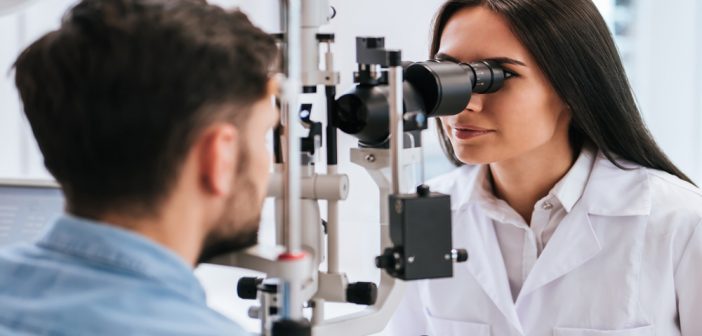National Eye Exam Awareness Month is an ideal time to have an eye exam. Here are some reasons why it’s important to have your eyes checked.
Eye Exams Reveal More Than How Well a Person Can See
Maintaining proper vision is a major component in an individual’s quality of life, but routine eye examinations can also identify certain eye diseases.
Glaucoma
Glaucoma is one of the primary reasons for blindness. When a person has open angle glaucoma, eye pressure will increase, which is typically painless, and it will eventually cause optic nerve damage. Narrow-angle glaucoma is different and causes severe pain in the eye. In addition, this type of glaucoma can also cause vomiting and nausea.
An eye doctor can diagnose and treat glaucoma with medication, and he or she can even administer eye surgery to clear a channel in the eye that has been blocked.
Retinal Detachment
The retina is located at the back of the eye and enables an individual to see properly. When a person has a detached retina, he or she usually will not feel pain. However, they may have symptoms that include flashes of light in their field of vision or blurred vision.
Diabetic Retinopathy
Individuals with uncontrolled diabetes can develop this eye disease. When left untreated, it can cause damage to the retina and blood vessels in the eye. Those with this condition may have difficultly differentiating between colors or experience blurry vision.
Hypertensive Retinopathy
This happens to those with uncontrolled blood pressure that is too high. This condition causes the same type of damage to the eyes as uncontrolled diabetes. Symptoms may include headaches, swollen eyes, and burst blood vessels in the eyes. In many circumstances, individuals will not show any signs of the condition until it is advanced.
Age Related Macular Degeneration
There are two types of this condition: dry macular degeneration and wet macular degeneration. With wet macular degeneration, individuals may experience hazy vision or an area that is blurred in their field of vision. If this condition is treated early, there are a variety of medications that can effectively slow vision loss. Dry macular degeneration may not produce any symptoms in its early stages, which is why many individuals are not diagnosed with the condition until it has progressed. With this condition, individuals may experience blurred vision and loss of central vision.
Improved Performance at School
Children and adult students may have a tough time performing to their best abilities if their vision is impaired. In fact, research has shown that an estimated one in four school-age children have some type of visual impairment. By getting routine exams and proper eye care treatment, children have a better chance to succeed at school.
As most children begin school, it’s the perfect time to have an eye exam. Getting children seen before or at the beginning of the school year will allow them to get corrective treatment and perform well from the start.
Improved Job Performance
Routine eye exams can also help individuals perform better at their jobs, which is especially true for those who work at a computer. Eye strain from computer screens can cause headaches and blurred vision. Corrective treatment, such as glasses or contacts, can help reduce eye strain and ultimately help improve job performance.
Why Eye Exams are Important for Every Age Group
Regular eye exams are crucial for optimal eye health at every stage in an individual’s life.
Babies and Toddlers
Research has shown that 80 percent of what young ones learn is via their eyes. When a baby or toddler has visual impairment, it can affect his or her cognitive, neurologic, emotional, and physical development. Parents and caregivers can schedule eye exams for their little ones at six months, between two to three years old, and just prior to kindergarten.
School-Age Children
Only about 14 percent of children get routine, comprehensive eye exams before they start kindergarten or the first grade. In addition, more than 12.1 million students have some type of visual impairment, and an estimated 60 percent of students who have problems learning also have undetected vision problems. Children in school should have an eye exam once per year. It is recommended to get a child’s eyes examined before the start of the school year.
Adults
It is estimated that more than 3 million individuals over 40 have some type of visual impairment. In addition, almost 90 percent of these individuals reported to use a computer at least three hours per day and can develop vision problems due to computer eye strain. Individuals who have had laser vision surgery or those with a history of good vision should still maintain routine eye exams. It is recommended for adults to have an eye exam annually.
Older Adults
Seniors are more likely to develop cataracts, macular degeneration, and glaucoma. The leading cause of vision loss among individuals over the age of 65 is macular degeneration. It is estimated that at least half of us will have developed cataracts by the time we are 65, and almost everyone will have one by the time they reach 75. Seniors should have their eyes examined once a year to ensure that every eye issue is promptly treated.
The best way to ensure that you and your family’s eyes stay healthy is to have an annual eye exam, and National Eye Exam Month is the perfect time to schedule an appointment.









